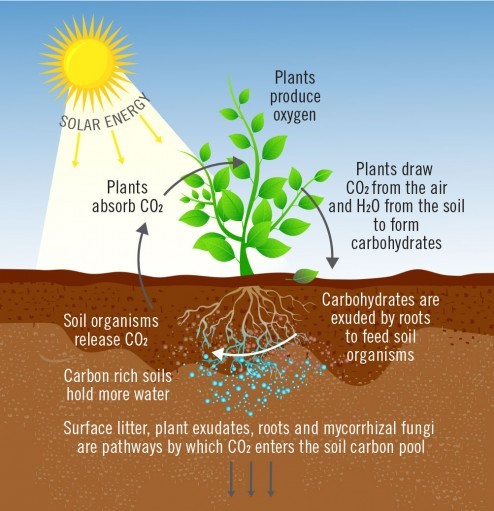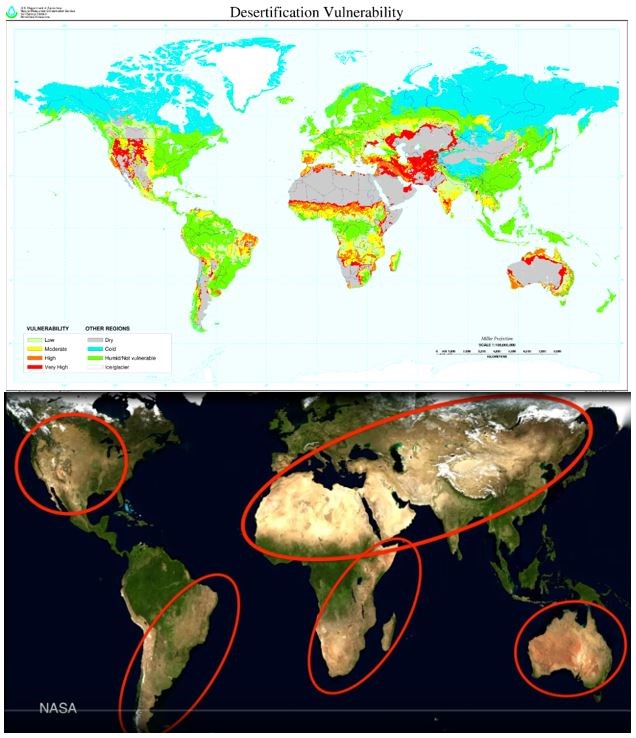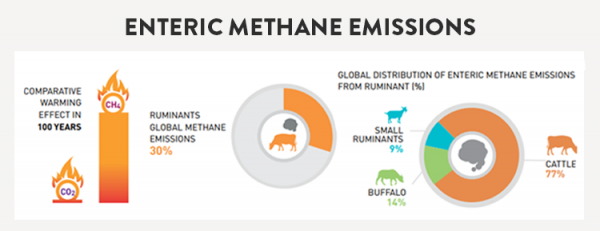New rebuttal to the myth 'Holistic Management can reverse Climate Change'
Posted on 18 March 2019 by Seb V
This is the new Basic rebuttal to the myth 'Holistic Management can reverse Climate Change'. There's also an Advanced rebuttal.
The Myth:
Holistic Management can reverse Climate Change
“Holistic management as a planned grazing strategy is able to reverse desertification and sequester atmospheric carbon dioxide into soil, reducing atmospheric carbon dioxide levels to pre-industrial levels in a period of forty years.” (Allan Savory, 2014)
The Rebuttal:
Holistic Management is a form of grazing management that has become popularised in recent years by Allan Savory, founder of the Savory Institute. The management technique has been subject of international attention, mainly due to the infamous TED talk that Savory gave in 2014. Savory preaches that Holistic Management, applied to most of the world’s grassland, can increase productivity of farms and reverse climate change. His explanation is that livestock, grouped in large herds, will ‘mimic nature’ and increase plant growth because of this. The increased plant growth will then, according the Savory, be able to store a great deal of carbon into soil by taking the carbon out of the atmosphere, thus reducing the level of carbon dioxide contributing to the greenhouse effect. He claims all of this can be achieved in 40 years.
Quite simply, it is not possible to increase productivity, increase numbers of cattle and store carbon using any grazing strategy, never-mind Holistic Management. There are several factors which are important in controlling the ability of soils to store carbon dioxide from the atmosphere. A list of these factors, and their importance and relevance to Holistic Management, is listed here:
The Carbon Cycle
Processes such as photosynthesis, plant respiration and bacterial respiration are all part of the cycle of carbon in and out of the atmosphere. Levels of each process determine if the carbon is stored in soil, used or is released. Plants, for example, depend on carbon for growth. In photosynthesis, energy from the sun allows plants to extract carbon dioxide in the atmosphere for its own growth, producing oxygen as a waste product. The additional carbon not used for growth is stored in soil as something called humus, which gives soil its volcanic colour. The darker the colour of the deep soil, the increased level of soil organic carbon (SOC). SOC will be increased if the level of photosynthesis is high but is also dependent on the presence of soil microbes and nutrients. The level of SOC determines soil quality and potential to store even more carbon (Ontl & Schulte 2012, Figure 1).

Figure 1: A simple version of the carbon cycle, related to how plants cycle carbon for growth, release, and storage. Source: https://ecosciencewire.com/2016/06/09/the-hurdles-to-carbon-farming/
However, stored carbon can also be lost from soils. Damage to soils, like erosion and increased decomposition, leads to an overall loss of carbon, where their potential of the soil to store carbon is outweighed by carbon losses. This carbon seeps from the soil back into the atmosphere, further increasing the greenhouse effect.
Carbon losses over time
Applying a new grazing technique on grasslands which have been mismanaged may indeed have positive results in terms of soil carbon storage during the first few years. But the main problem is that storage slows after the initial change, and over a long period of time (such as 50 years), the storage potential of the soil is maximised as it approaches an equilibrium (Nordborg, 2016). This effect is more observable in dry regions of the planet. This is because dry regions have lost much of their soil content, therefore having low carbon storage potential. They are at risk of completely drying out because of increasing temperatures and more at risk to the detrimental effect of mismanaged grazing (Lal, 2004).This makes it unreasonable to apply Holistic Management to such dry areas, where the intense grazing would no doubt leave soils further damaged. In fact, one of the principals of Holistic Management - focusing on using the intense hoof action of cattle – has been claimed by the Savory Institute to increase the absorption of water by soils. However, several studies in fact stated that the opposite effect was seen. When comparing land that was not grazed with land that had been managed using a short rotational grazing system (which is very similar to Holistic Management in its ideas), water infiltration was significantly reduced, and the hoof action did not improve incorporation of litter into soil (Dormaar et al. 1989, Holechek et al. 2000).
Long term studies on the effect of grazing on soil carbon storage have been done before, and the results are not promising. Two studies – by Bellamy (2005) and Schrumpf (2011) – studied soil carbon data and soil organic carbon, respectively, over periods of 25 years and a range of 10-50 years in European grasslands. Bellamy’s study came to the conclusion that there was no significant change in soil organic carbon stocks over this long period of time, and Schrumpf’s study showed that as an overall, there was no clear pattern in carbon storage. Increases and decreases were observed, as well as times of stability. There was no overall pattern to suggest that grazing had any sort of positive effect on carbon storage.
Increasing temperature
Allan Savoury wants to expand Holistic Management to cover land across the globe, that he believes can be saved from complete desertification by using his grazing technique. Simply, this is not possible due to the variety of climates that exist around the world, and in many cases, land which he has highlighted as targets to save by his technique cannot support livestock. This is clear in Figure 2:

Figure 2:
Top: A view of the world’s land and their vulnerability to desertification by climate change. Points to note are the land in grey – which is already dry – and the red / orange areas which at a high risk. Source: https://www.nrcs.usda.gov/wps/portal/nrcs/detail/national/nedc/training/soil/?cid=nrcs142p2_054003
Bottom: The land that Savory highlights at land that is desertifying, taken from his TED talk. Note the difference between the correct figure (above) and Savory’s “estimate”. Source: https://www.youtube.com/watch?v=vpTHi7O66pI&t=255s
To expand on this, land which is already desert, such as the Sahara, cannot be revived by any management technique. The climate is too harsh, cannot support plant growth, and therefore cannot support livestock. This is the same case for land which is at high risk of desertification, in countries such as Iran and Iraq (Figure 2). This leaves semi-arid and humid land as the only potential land able to support livestock. Climate change is likely to further damage these soils further. The explanation is that, as temperature increases, soil becomes drier. The soil becomes vulnerable to erosion, less likely to retain water, and levels of soil organic content will go down as the soil gets drier (Dalias et al. 2001). The carbon will seep out from soil back into the atmosphere. The soil changes from a carbon “sink” to a carbon “source”. In turn, this affects livestock. As the plant productivity gets worse, the livestock have less to feed on, and overall productivity of the farm goes down.
Methane
Methane, CH4, is a potent greenhouse gas. It is capable of trapping heat in the atmosphere, like carbon dioxide, and is a significant factor in global warming. Melting permafrost, methane clathrates in ocean and mostly importantly emissions from livestock are responsible for a large proportion of methane that has been released into the atmosphere. When cows burp or excrete gas, they release methane (Figure 3). This methane then accumulates in the atmosphere for a period of around 12 years before it is broken down into water vapour and carbon dioxide, which are both greenhouse gases themselves (Ripple et al. 2014). As methane has a shorter atmospheric lifetime than carbon dioxide, its global warming potential is 28 times higher (Shindell et al. 2009). Part of the problem is that as the human population grows, the demand for meat grows too. At the time of writing, the population of livestock (ruminants) is increasing by 25 million per year (FAO). This has the knock-on effect of increased methane emissions, and further global warming.
Allan Savory has refused to put a limit on the number of livestock that a farm can accommodate using the Holistic Management practice, claiming that bacteria capable of breaking down methane will solve this problem. He also has claimed that the number of wild ruminants in the past is equal to the current number of domesticated ruminants. This is inaccurate. The level of methane in the atmosphere today is 2.5 times higher than the level recorded before the industrial revolution (IPCC, 2001). This number has certainly increased as result of the expansion of the meat industry, in addition to other reasons listed. The methane-eating bacteria are common in both oxygen rich and oxygen depleted environments but are certainly not capable of breaking down the huge pool of methane that is present in the atmosphere today.

Figure 3: The Methane Emissions which are attributable to cattle. Note the increased warming effect of methane over a 100-year time scale, compared to carbon dioxide. Source: http://www.ccacoalition.org/en/activity/enteric-fermentation
Overall, methane emissions have continued to rise at an unprecedented rate over the past 250 years. Reducing livestock-based methane emissions will have a positive effect on global warming. For Holistic Management to work, there must be a balance between the amount of methane produced by livestock and the amount of carbon stored, which is known to be small.
Conclusions
Because of the complex nature of carbon storage in soils, increasing global temperature, risk of desertification and methane emissions from livestock, it is unlikely that Holistic Management, or any management technique, can reverse climate change. Studies of several grazing techniques and carbon storage have produced no ground-breaking results to suggest that Savory’s idea is doable. With increasing temperature, the ability of soil to store carbon will decrease, and grazing will likely speed up the process of desertification. Finally, methane emissions from cattle are currently too high, and their effect on global warming cannot be ignored. Adding more livestock to the planet will not help this.
References
Bellamy, P.H. et al., 2005. Carbon losses from all soils across England and Wales 1978-2003. Nature, 437(7056), pp.245–248.
Dalias, P. et al., 2001. Long-term effects of temperature on carbon mineralisation processes. Soil biology & biochemistry, 33(7), pp.1049–1057.
Holechek, J.L. et al., 2000. Short-duration grazing: the facts in 1999. Rangelands Archives, 22(1), pp.18–22.
Johan F. Dormaar, Smoliak, S. & Walter D. Willms, 1989. Vegetation and Soil Responses to Short-Duration Grazing on Fescue Grasslands. Journal of Range Management, 42(3), pp.252–256.
Lal, R., 2004. Soil carbon sequestration to mitigate climate change. Geoderma, 123(1), pp.1–22.
Monica Petri, Caterina Batello, Ricardo Villani and Freddy Nachtergaele, 2009. Carbon status and carbon sequestration potential in the world’s grasslands. FAO. Available at: http://www.fao.org/3/a-i1880e.pdf.
Nordborg, M., 2016. A critical review of Allan Savory’s grazing method. SLU/EPOK – Centre for Organic Food & Farming & Chalmers. Available at: http://publications.lib.chalmers.se/records/fulltext/244566/local_244566.pdf.
Ontl, T.A. & Schulte, L.A., 2012. Soil carbon storage. Nature Education Knowledge, 3, p.3(10):35.
Schrumpf, M. et al., 2011. How accurately can soil organic carbon stocks and stock changes be quantified by soil inventories? Biogeosciences , 8(5), pp.1193–1212.
Shindell, D.T. et al., 2009. Improved attribution of climate forcing to emissions. Science, 326(5953), pp.716–718.
Thornes, J.E., 2002. IPCC, 2001: Climate change 2001: impacts, adaptation and vulnerability, Contribution of Working Group II to the Third Assessment Report of the Intergovernmental Panel on Climate Change, edited by J. J. McCarthy, O. F. Canziani, N. A. Leary, D. J. Dokken a: BOOK REVIEW. International Journal of Climatology, 22(10), pp.1285–1286.































 Arguments
Arguments






























Your silliness accusation (a little condescending, I have some clue about these issues) is not warranted, because the boundaries of the discussion were not adequately defined. The subject of this post is clearly agricultural resources management and more specifically livestock. Holistic management therefore has here been understood here as holistic mangement of such resources. The climate stabilization wedges concept put forth initially by Pacala and Socolow include that and much more. I understand what a holistic approach is (I have to do it in my work all the time), but here we are treating more specifically of livestock (or we were, from the posts preceding mine).
I agree that there is some misunderstanding, and even possibly some level of strawman in the OP; they seem to have understood the initial claim as the ability of holistic grazing management to single handedly stop and reverse warming. I don't think they are wrong in their argument that it is not enough. Savory and yourself felt this was wrong amd missed the point, because you understand holistic management in a much more inclusive way, extending far beyond grazing alone; I get it. It's a very different claim. I note, however, that Allan Savory's post higher in this thread is focused on agricultural resources, whereas you expand to even larger horizons.
My question, the most important part of the post you taxed with silliness remains unanswered: is it possible to integrate in any sustainable fashion the roughly 1 billion heads of cattle (estimates vary) we have right now in a holistic agricultural management model? How much land and water does that take? Other agricultural production need water and land too. Do the numbers add up? Perhaps Mr Savory has done the maths, and I missed it in his earlier contribution, in which case a reminder will be welcome. If not, then that needs attention.
I agree that a holistic socio-economic model is the best approach, that is very much convergent with the sustainable development goals that OPOF has discussed at length; different name, similar idea. However, you shouldn't accuse me of being silly just because I stuck to the subject at hand, as did Mr Savory himself.
@51 Phillip,
Your new question:
The answer is yes.
The industrial model is labor efficient, not land efficient. Holistic management has shown to be land efficient. So land efficient in fact that we will even have the possibility of first reversing desertification then potentially rewilding large areas of degraded land.
However, the elephant in the room is corn/soy. The over-production of corn and soy will need to stop. The land to be restored to grazing needs to be non-human food use commodity crops like corn/soy for biofuels and CAFO feeds, not forests.
Currently any reductions in corn use for animal feeds is immediately picked up for biofuels and other industrialized uses, rather that actually giving the land the rest it needs to recover.\
Scientific America had an interesting article about this:
I have tried to explain to people many times that the real issue here is corn not cows. And specifically corn for ethanol. And drop of meat use in the industrialized system we have now (fed by grains) is quickly taken up for ethanol production. That's what must end. Solar wind hydroelectric etc.. are all much more efficient choices for our energy needs. Then farmers have the option to raise food in a land efficient manner. In fact for a while we may have too few animals back on the land to optimally restore it. Especially since the vast wild herds are about 90%+ gone. But Holistic management, which includes Holistic planned grazing, (but not only) does have a way to deal with that too, while the wild herds, grassland birds, insects, soil food web, etc have a chance to recover.